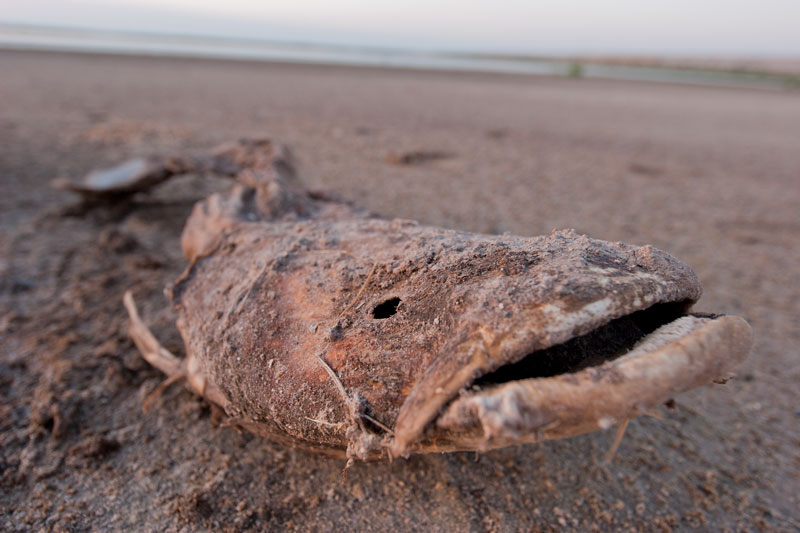
Texas Water Plan Could Make It Rain… For Special Interests

Above: Dead catfish at San Angelo's dried-up OC Fisher reservoir
My editor, God bless him, stifles a yawn every time I broach the subject of water. Tedious, arcane, gummed up with jargon only a policy wonk would love. What the hell is an acre-foot, anyway? Is “conjunctive use” something you can get in your eye? PGMA, WAM, GAM, RWPG, DFC—how can something composed of just three atoms be the center of such a frustratingly complex mess of science and government?
Yet perhaps never has water—or more specifically the increasing scarcity of it—been discussed so much. In the last year alone, I counted at least a dozen separate water conferences in Texas, from Brenham to San Angelo, often featuring the same individuals pleading for public awareness and action. Typically these confabs are made up of the business-friendly conservationist, the water utility executive, the academic and the concerned lawmaker (often state Rep. Allan Ritter, a Republican from southeast Texas who chairs the committee in the Texas House that oversees water issues). Chicken Littles these folks are not. Their views converge around a simple message: Too many people, not enough water … we gotta do something. And there is general agreement on the main to-do item: funding the state water plan. The latest iteration of the plan recommends 562 water projects, ranging from water conservation to massive new reservoirs, that would supply 9 million acre-feet of water by 2060 at a cost of $53 billion.
Have you read it? I didn’t think so. Published every five years, the state water plan has the heft of a Russian novel but, with chapters like “A Brief History of Texas Water Planning,” possesses all the narrative drama of a car repair manual. Drafted by more than 400 “stakeholders” and organized into 16 regional planning groups, the water plan is a bottom-up affair. The upshot of this truly impressive production, however, is neatly contained in a cover letter addressed to “the People of Texas” from Texas Water Development Board Chairman Edward Vaughan: “The primary message of the 2012 State Water Plan is a simple one: In serious drought conditions, Texas does not and will not have enough water to meet the needs of its people, its businesses, and its agricultural enterprises.”
That grim logic has gripped a wide swath of the political mainstream and has increased the chances that the Texas Legislature will at least make a down payment on funding the plan in 2013.
Rep. Ritter and state Sen. Troy Fraser (R-Horseshoe Bay) has filed legislation that would transfer $2 billion from the state’s Rainy Day Fund (how poetic is that?) for water-supply projects. That should be enough to create a revolving fund capable of covering the state’s share of the water plan, about $27 billion. Gov. Rick Perry, Lt. Gov. David Dewhurst and speaker of the House Joe Straus have all expressed interest in funding the plan.
Problem solved, then?
Not exactly. There is a risk that a $27 billion water war chest could become a slush-fund for giant, unnecessary infrastructure projects. There’s big money in building reservoirs, but not so much in fixing leaky pipes or getting farmers to switch to center-pivot irrigation systems. I mean, who’s lobbying for a sensible plumbing code?
“I think we have the potential to make some legitimate progress in addressing the water needs of Texas as long as we don’t just focus on more infrastructure,” said Ken Kramer of the Sierra Club. “I think the risk we see this session is that money be put into building infrastructure and that’s it.”
Although the state has come a long way toward conservation, the knee-jerk Texas reaction to water woes is to engineer our way out of it. That’s understandable, to a degree. Modern Texas owes its existence, in part, to a frenzy of dam-building from the 1950s through the 1970s. Old habits die hard. The state water plan calls for 26 new reservoirs, including the much-maligned Marvin Nichols Reservoir on the Sulphur River. If built, that reservoir would wipe out 30,000 acres of bottomland forests, disappear 40 miles of river and necessitate the condemnation of tens of thousands of acres of private land. Nichols would cost $3.4 billion and provide up to 470,000 acre-feet of water to the Metroplex each year.
But should the rest of the state subsidize such a costly and destructive project? The Metroplex hasn’t exactly conserved water. At its current rate, almost 50 years from now, in 2050, Dallas will still be using 140 gallons per day per person. This is a risibly unambitious goal. San Antonio and El Paso have thrived for years at 100-120 gallons per day per person.
The good news is that there is some appetite for advancing conservation. Ritter’s draft legislation requires that 20 percent of the money go toward conservation. Environmental groups would like to see that bumped to one-third, a reasonable threshold.
Conservation is elegant. It rarely requires expensive infrastructure, it’s cheap and it reflects the fact that God, despite Rick Perry’s prayers, isn’t making any new sources of water.


